The Importance of Attic Insulation: A Winter Maintenance Guide
As cold weather approaches, many San Francisco Bay Area homeowners focus on heating system tune-ups and weatherproofing doors and windows. To stay warm and reduce energy costs, it’s equally important to prepare your attic insulation for winter conditions.
Without adequate attic insulation, your HVAC system works harder to maintain a consistent temperature, resulting in higher utility bills and uneven heating. This winter maintenance guide explores why energy-efficient insulation is important, how much insulation you need for your attic, and which options work best for Bay Area homes.
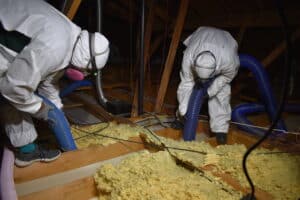
Why Attic Insulation Matters in Winter
Heat naturally rises, which means without a proper barrier in your attic, warm air escapes through your roof while cold air seeps in. Attic insulation helps maintain the temperature you've paid to create inside your home.
In the San Francisco Bay Area, winter temperatures typically range from the low 40s to mid-50s, with occasional dips into the 30s. Bay Area homes experience morning fog, coastal moisture, and varying microclimates, from windswept coastal areas to warmer inland valleys. Attic insulation and air sealing strategies need to be tailored to your specific location.
Energy-efficient insulation also prevents moisture buildup in your attic space. When warm, humid air from your living areas meets cold surfaces in an under-insulated attic, condensation can form, potentially leading to mold growth and structural damage over time. One of the added benefits of attic insulation is that it contributes to a healthier home environment for your family.
Common Signs Your Attic Needs Better Insulation
When you notice these telltale signs your attic needs more insulation, you can address potential problems before you waste more energy or experience cold discomfort.
- Higher energy bills without a corresponding change in usage, suggesting your attic may be losing heat, and your HVAC is working extra hard to compensate
- Cold spots or uneven temperatures throughout your home, especially in upper-floor rooms or near exterior walls
- Ice dams on the roofs of higher-elevation homes, which develop when heat escapes through the roof during winter storms
- Drafts and cold air coming through light fixtures, outlets, or attic access points due to poor sealing
- Visible insulation issues, like if you can see the floor joists in your attic because the insulation is insufficient
How Proper Insulation Improves Energy Efficiency
Better insulation means less heat transfer between your living space and the outdoors. When your home maintains its temperature naturally, your heating system cycles less frequently, consuming less energy and reducing wear on equipment.
Northern California homeowners who invest in proper insulation installation typically see lower monthly utility bills and reduced HVAC maintenance needs. Proper attic insulation and air sealing can help many homeowners save 15% or more on total energy bills. Homeowners in Santa Clara and San Mateo Counties may qualify for incentives through local energy efficiency programs, which help offset the initial installation costs.
Before adding new insulation, proper air sealing is fundamental to maximizing performance. Gaps around pipes, wiring, and attic access points allow conditioned air to escape even with adequate insulation in place. Sealing these air leaks first creates a more effective thermal envelope.
Best Types of Attic Insulation for Cold Weather
The best attic insulation for cold weather depends on your home's configuration, existing insulation, and budget. Several materials work well in Bay Area climates:
- Fiberglass insulation remains the most popular choice due to its effectiveness and affordability. Made from fine glass fibers, it can be installed as batts or blown-in loose fill.
- Cellulose insulation consists of recycled paper products treated with fire-resistant chemicals. This eco-friendly option performs well in cold weather and is particularly effective at filling irregular spaces.
- Blown-in insulation, whether fiberglass or cellulose, excels at covering hard-to-reach areas and creating a seamless thermal barrier. Professional installers use specialized equipment to distribute the material evenly throughout your attic space.
As part of your winter insulation checklist, consider the material, thickness, coverage, and installation quality, especially in hard-to-reach places.

How Much Insulation Do You Need in Your Attic?
The Greater San Francisco Bay Area lies mainly in Climate Zone 3. The suggested R-value attic insulation range for uninsulated attics in this area is R30 to R60, although ENERGY STAR recommends R49 for optimal efficiency standards. If you already have three to four inches of existing insulation, adding R25 to R38 can bring your attic up to recommended levels.
Different materials have different R-values, which measure how well a material resists heat flow, so calculating how thick your attic insulation should be depends on the insulation material you choose:
- Fiberglass batts provide around R2.9 to R3.8 per inch.
- Loose fiberglass provides around R2.2 to R2.9 per inch.
- Cellulose fibers provide around R3.6 to R3.8 per inch.
- Modern mineral wool provides around R4.0 per inch.
In other words, to achieve R38 to R49, you’ll typically need anywhere from 13 to 18 inches of insulation depth. Proper attic insulation installation matters as much as quantity. Uneven distribution or compressed insulation loses effectiveness.
Professional vs. DIY Attic Insulation: What to Know
Professional attic insulation installation is often the smarter choice. Experienced installers bring expertise in identifying problem areas, properly sealing air leaks before adding air insulation, and achieving more even coverage throughout your attic space.
Installation quality significantly impacts performance. Compressed or poorly installed insulation can perform far worse than its stated R-value. Fiberglass batts that are squeezed into tight spaces lose their insulating properties because the air pockets that provide thermal resistance become compressed.
The cost of attic insulation installation by a professional varies based on material choice, attic size, and whether old insulation needs removal. While DIY might seem cheaper upfront, professional installation offers better long-term value through proper technique, warranty coverage, and access to energy rebates that often require professional installation to qualify.
What happens if you skip attic insulation before winter? You could face higher heating bills, uncomfortable temperature fluctuations, and increased strain on your HVAC system throughout the cold months.

Schedule Your Attic Insulation Service with TRIO Heating, Air & Plumbing
Don't wait until winter's chill leads to a drafty home. If you're searching for attic insulation services near you, TRIO Heating, Air & Plumbing offers professional installation throughout the Bay Area, helping homeowners enhance comfort while reducing energy costs.
Contact us today at (415) 226-4257 to schedule a professional attic insulation inspection and estimate. Let TRIO help you create a warmer, more energy-efficient home this winter season.
5 Signs Your Water Heater Needs Maintenance Now
Your water heater is one of your home’s most vital unsung heroes. These systems are responsible for every hot shower, clean dish, and fresh load of laundry, which means it’s a big problem when they shut down unexpectedly. The best way to avoid sudden water heater failures is by keeping up with preventative water heater maintenance. In this guide, we’ll explain why maintaining your water heater is so important and cover the top 5 signs that it’s time to schedule a water heater service appointment.
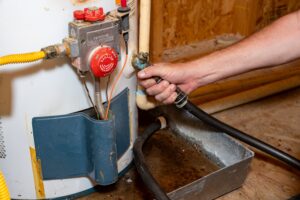
Why Water Heater Maintenance Matters
Water heater maintenance is vital when it comes to keeping your unit running safely, reliably, and efficiently. Over time, water heater sediment buildup forces the system to work harder and increases its energy usage. By flushing the tank and periodically maintaining the whole system, you’ll keep your energy costs to a minimum.
Safety is another major reason to learn how to maintain a water heater, especially if yours is gas-powered. Because of the extreme danger of gas leaks, it’s important to have your system periodically inspected and tuned up to ensure gas fittings are in good condition and don’t pose a risk to your home and family. And of course, proper maintenance helps to keep your system running smoothly, helping you avoid shutdowns, premature water heater repair, or even full system replacement.
1. Lukewarm or Inconsistent Hot Water
One of the most irritating and obvious signs your water heater needs repair or a tune-up is if the system is putting out lukewarm or inconsistently heated water. If your water heater isn’t heating properly, it can be a sign of a few issues.
If you’re getting hot water, but only in small amounts, it means one or both of the system’s heating elements have failed, and the parts will need to be replaced. If your water supply is steady, but it only reaches lukewarm temperatures, it’s usually caused by excess sediment buildup in the tank, meaning it’s time to flush the water heater.
2. Strange Noises Coming from the Tank
Another common issue is a water heater making noise while running. While some sound is expected, rumbling, popping, or high-pitched whining noises all indicate an issue with the unit. If the bottom of your tank is full of sediment, it can cause the unit to overheat, allowing water to boil inside rather than just heating up. Try flushing the tank to see if it stops the noise, and if not, contact a plumbing professional for help.
3. Discolored or Rusty Water
If water is coming out of your taps with a strange color or a rusty appearance, it usually means the water heater’s sacrificial anode rod needs to be replaced. This component is designed to rust before other components, protecting the rest of your system. But naturally, these sacrificial rods will need to be replaced once they’ve done their job — usually every 3 to 5 years.
4. Water Around the Base of the Tank
Obviously, the water is supposed to stay inside the tank. If you’re noticing water pooling around the unit, it usually means there’s a leaking pipe or connection nearby. If the leaking water is hot or warm, you can narrow down the problem to the outlet pipes. Checking and tightening these connections is a key part of routine water heater service.
5. Rising Utility Bills Without Explanation
A subtle but important sign that you need professional water heater maintenance is if you notice your energy bills rising without any change in your usage. As your system gets older, dirtier, and more worn out, it’s forced to work harder to do its job, meaning it consumes more electricity or gas. There are many reasons for rising energy bills, such as sediment buildup, a failing heating element, or general component wear.
The Benefits of Routine Water Heater Maintenance
Now that we’ve looked at a few water heater maintenance tips, why do homeowners need to keep up with this task? There are several benefits to regular water heater maintenance, including:
- Improved energy efficiency
- More reliable hot water supply
- Reduced chance of water heater shutdowns
- Less risk of a water leak damaging your home
- Extends the life of your water heater
- Ensures your safety from gas leaks or electrical hazards
- Saves you money on water heater repair and replacement
How often should you service your water heater? To get the full benefits listed above, we suggest getting your system professionally inspected, tuned up, and maintained once a year. This gives your plumbing tech a chance to not only clean and maintain the components but also to flush the tank, inspect all gas and water connections, and ensure the entire system is ready to run reliably and safely.
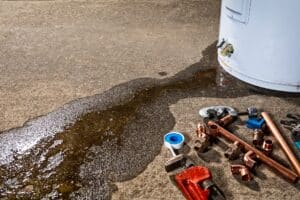
Schedule a Water Heater Check-Up with TRIO Heating, Air & Plumbing
With the right approach to water heater maintenance, homeowners can enjoy safe, reliable, and energy-efficient water heating for the full 8- to 12-year lifespan of their system. While some tasks are relatively DIY-friendly, such as flushing the tank or replacing the anode rod, many repairs and tune-up jobs are best left to the professional. Plus, when you allow an expert to maintain your water heater, you allow them to catch other issues with your system earlier on, protecting you from further damage or breakdowns.
If you’re looking for skilled, effective, and quick water heater maintenance, the team at TRIO Heating, Air and Plumbing has you covered. Our plumbing technicians have extensive experience working with water heaters of all makes and models, from conventional tank-style units like we discussed here, all the way to modern tankless systems. With our tools and knowledge at your disposal, you get the peace of mind knowing your unit has been tuned to perfection and is ready to serve your home for the year to come.
Ready to stop living in fear of that next water heater issue? Contact us today to schedule your next water heater service appointment.
Is It Time for a New Water Heater? Signs You Shouldn't Ignore Before Winter
Wondering when to replace your water heater? Should you replace your water heater before winter? How long do water heaters last? TRIO Heating, Air, and Plumbing is here to help you find the perfect solution to any plumbing issue, including expert water heater services.
Our qualified plumbers offer reliable water heater replacement, helping California homeowners enjoy uninterrupted hot showers, clean dishes, and improved home comfort. We learn about your unique needs and suggest the best replacement water heater based on factors such as the number of occupants in your house, your average hot water use, and your preferences. If your water heater shows signs it’s nearing the end of its life, rely on the professional plumbers at TRIO Heating, Air, and Plumbing.

Is Your Water Heater Ready for Winter?
Preparing your water heater for the chilly California winter is a smart idea, even if it’s already in good shape. Make sure your water heater is well insulated, and schedule professional maintenance, including a tank flush and a full inspection, to ensure it’s ready to operate efficiently through the winter season.
Top Signs You Need a New Water Heater
The top signs you need a new water heater include:
- Age: A typical water heater lasts about 10 years. If yours is nearing the end of its lifespan, it’s better to replace it now rather than face an emergency in a few months.
- Strange sounds: Squealing, banging, or rumbling are signs of a problem with your water heater.
- Rust: Corrosion on the tank or the lines, or discolored water, are signs that the system is deteriorating.
- Leaks: Water leaks from seams, joints, or seals are a sign of trouble. You may only need a repair for a leak, but consider replacement if the unit is older.
- High energy bills: A failing system uses more energy to heat water, which drives up your bill.
- Frequent repairs: If you’re spending a lot fixing a failing water heater, it’s usually more cost-effective to replace it.
- Unit failure: If the water heater fails, bursts, or stops heating your water, call TRIO Heating, Air, and Plumbing for emergency water heater services.
Why Replace Your Water Heater Before Winter?
It’s important to replace your failing water heater before winter for several reasons:
- Higher-than-average hot water use may cause a winter breakdown, leaving you without hot water on a cold day.
- Upgrading an older water heater to a more efficient model saves you money on heating your water by using less energy.
- Planning to replace your water heater before winter gives you time to plan your purchase, find the right plumber for the job, and save up for the investment.
If you don’t replace a failing water heater in time, you risk having to deal with serious water heater issues in winter, such as:
- Breakdowns: If you don’t address your failing water heater in time, you risk inconsistent hot water, low water pressure, or no hot water at all.
- Tank failure: A water heater tank that builds up high pressure due to ongoing issues could catastrophically fail, bursting and flooding your home with hot water.
- Safety issues: A gas water heater that’s experiencing issues with the pilot light, ignition, gas line, or other parts could lead to a dangerous gas leak.
Water Heater Repair vs. Replacement: What’s the Right Move?
You likely don’t need to replace your water heater if it’s only a few years old and the issues you’re having are minor. At TRIO, we provide expert water heater repairs, solving common issues like:
- Faulty thermostats
- Bad gas connection
- Sediment buildup
- Failing heating elements
We use a detailed diagnostic process to assess your water heater and identify the underlying problem.
Having trouble deciding between water heater repair vs. replacement? Schedule an inspection with TRIO, and one of our experienced plumbers will give an honest assessment of your system.

Benefits of Installing a New Water Heater
Sometimes, repairs aren’t enough, and you need a new, modern replacement. The top benefits of a new water heater include:
- Peace of mind: Enjoy long-term reliability and comfort, without worrying whether you’ll have enough hot water to get through the day.
- Energy savings: Modern energy-efficient water heaters use less energy to heat and store hot water.
- More options: Choose between a traditional tank water heater or an energy-efficient tankless water heater. We go over the pros and cons of each and help you decide which is best for your home.
Why Hire a Professional for Water Heater Replacement?
It’s important to hire a knowledgeable, experienced plumber for professional water heater services rather than trying to do it yourself. A certified plumber will ensure the following:
- Safety: You don’t want to mess around with your home’s plumbing, electrical system, and gas lines. It’s dangerous to install the heater yourself, and you could make a serious mistake that could result in burns, shocks, or gas leaks. Our plumbers are highly trained and experienced in all types of water heater services and will prioritize safety at all times.
- Code compliance: We make sure your new water heater is installed according to local codes and permits. This legal requirement guarantees that your water heater is installed safely.
- Performance: If you don’t install your water heater correctly, it won’t work as it should. A plumber will make sure your water is the correct temperature, the thermostat is working, and the system runs efficiently.
- Warranty compliance: Most manufacturer warranties will be instantly voided if you install your water heater yourself.
At TRIO Heating, Air, and Plumbing, we take the time to make sure our plumbing installations are done right. We’ll prepare the area, install your new water heater per the manufacturer’s specifications, ensure secure, safe connections to your water, electrical, and gas lines, and test everything thoroughly before we leave.

Schedule Water Heater Services With TRIO Heating, Air, & Plumbing
Prevent wintertime water heater malfunctions and avoid last-minute emergency repairs with a new hot water heater installation from TRIO Heating, Air, and Plumbing. We offer high-quality plumbing services, including water leak detection and repair, water filter installations, and tank and tankless water heater repair, installation, and maintenance.
Our qualified team serves the Greater San Francisco Bay Area, including Alameda, Contra Costa, Marin, Napa, San Francisco, San Mateo, Santa Clara, Solano, and Sonoma counties. If you need water heater installation near you, our licensed California plumbers have you covered. Contact us today to schedule a professional water heater evaluation.
Crawl Space Insulation: Benefits and Best Practices for Homeowners
With your crawl space tucked away underneath your home, it’s easy to overlook the importance of insulation in this hidden space. Without a barrier from the elements, your crawl space can let in pests, moisture, and drafts that impact your home comfort and health.
Installing crawl space insulation creates a cleaner, more energy-efficient home by sealing cracks, controlling heat transfer, and regulating moisture levels. In this guide, we’ll explore all the benefits of insulating this often-overlooked space and explain the importance of professional installation by pros like TRIO Heating, Air & Plumbing for long-lasting comfort.
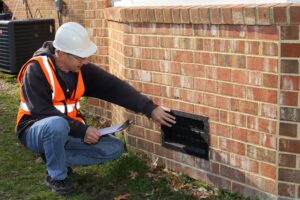
The Role of Crawl Space Insulation in Home Comfort
Even if your crawl space only takes up a small portion of your home, installing the right insulation can make a difference throughout your entire house. Insulation acts as a barrier against the outdoors, controlling moisture levels, temperature fluctuations, and unwanted drafts. Slowing the transfer of heat helps keep warm air inside during the chilly winter months and prevents hot, humid air from entering during the summer.
A well-insulated crawl space also helps keep drafts, pests, and allergens at bay by sealing gaps or cracks in the walls and floor. With protection from the outdoor elements, you’ll enjoy lower energy usage, cleaner indoor air, and a healthier environment for your entire family.
Top Benefits of Insulating Your Crawl Space
Upgrading your crawl space insulation keeps your home safe, comfortable, and cost-effective. Crawl space moisture control and reduced heat transfer can help improve everything from your energy consumption to your indoor air quality. Discover some of the top benefits of crawl space insulation below to see how a well-insulated space can make a difference in your home.
Lower Energy Bills
Crawl space insulation helps prevent heat transfer, keeping your HVAC systems from working harder than necessary to heat or cool your home. You’ll require less energy and notice savings on your monthly utility bills.
Better Indoor Air Quality
Air naturally flows from bottom to top within a home, meaning over 40% of the air you breathe comes from your crawl space. Proper insulation and sealing help prevent moisture issues, mold growth, and the entry of airborne contaminants, keeping them from affecting your indoor air quality.
More Consistent Temperatures
Crawl space insulation helps keep warm air from entering during the summer and heat from escaping in the winter, maintaining a more consistent temperature in your home throughout the seasons. You won’t have to deal with chilly floors on winter mornings or unbearably hot rooms during the summer.
Moisture and Mold Prevention
Proper insulation controls the moisture level inside your crawl space, reducing the risk of mold, mildew, and wood rot. By keeping the space dry, it protects your home’s structural integrity, minimizes health hazards, and prevents costly repairs down the road.
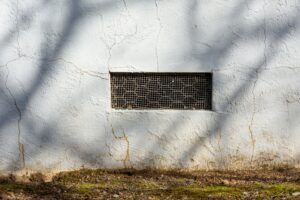
How to Know If Your Crawl Space Needs Insulation?
A poorly insulated crawl space can cause uneven temperatures, rising energy bills, and excess moisture inside your home. Performing a visual inspection and checking for the following signs that your crawl space needs insulation helps schedule service before minor problems worsen:
- Cold floors: If your floors feel extra cold when temperatures drop, a lack of insulation in your crawl space is likely allowing heat to escape from your home.
- High energy bills: Poor insulation allows for excess heat transfer, forcing your HVAC systems to work harder and use more energy to regulate the temperature in your home.
- Strange smells: Lack of insulation can allow moisture to enter your home, eventually leading to musty-smelling mold or mildew growth.
- Visible damage: Sagging or torn insulation, water stains, and wood rot in your crawl space are clear signs that you’re due for replacement or enhancements.
- Warping or creaking: Temperature fluctuations caused by poor crawl space insulation can cause wooden floors to expand and contract, resulting in warped boards and squeaking sounds when you walk on them.
Why Hire a Professional for Crawl Space Insulation?
Although it may seem straightforward, attempting to install crawl space insulation on your own can result in improper placement, moisture issues, and potentially costly future repairs. Hiring an experienced pro, like TRIO, helps ensure proper installation of your insulation, so you can enjoy long-term energy savings, consistent home temperatures, and avoid additional crawl space insulation costs down the road.
When you hire a professional for installation, they’ll check for existing issues, handle any necessary repairs, and find the best type of insulation for your space. Next, they’ll carefully install the insulation along joists and walls, secure it for long-term performance, and seal the area to prevent drafts and moisture issues. With help from a pro, you’ll boost your home’s energy efficiency, protect the structure, and create an overall healthier indoor environment.
Schedule Crawl Space Insulation with TRIO Heating, Air & Plumbing
If cold floors, rising energy bills, and mold growth are impacting your home comfort, call TRIO Heating, Air & Plumbing for professional crawl space insulation services. We’ll evaluate the condition of your crawl space insulation, determine if upgrades are necessary, and provide lasting solutions that improve your home comfort and value for years to come. With easy online scheduling, fast response times, and a team of skilled insulation experts, you can trust that we’ll get the job done right.
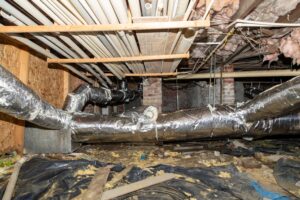
Frequently Asked Questions
What’s the best insulation for crawl spaces?
The best type of insulation depends on your climate, moisture levels, and crawl space design. The most common options include fiberglass batts, spray foam, and rigid foam panels. Our skilled insulation professionals can evaluate your space to determine the best type for lasting performance and efficiency.
Do I need both insulation and encapsulation for my crawl space?
Many homeowners benefit from both crawl space insulation and encapsulation. Insulation helps control your home temperature and energy loss, while encapsulation seals gaps and cracks to block out pests and drafts. Combining the two helps provide maximum energy efficiency, protection, and temperature control.
When should I replace or upgrade crawl space insulation?
Some of the top signs you’re due for an insulation upgrade include sagging, torn, or missing sections, visible moisture and mold, and temperature fluctuations throughout your home. If you notice any of these warning signs, contact our team for a professional insulation evaluation and replacement.
Why Installing a New AC in Winter Can Save You Money
As summer winds down and you explore places like Don Edwards San Francisco Bay National Wildlife Refuge less frequently, you’re probably not thinking about installing a new AC unit as the outdoor temperatures get cooler. However, choosing to install a new AC unit in winter provides an opportunity to save money in the summer.
Learn why winter is a smart time to install an AC unit, how to get special rebates and incentives, and the benefits of a professional AC installation in the winter months.
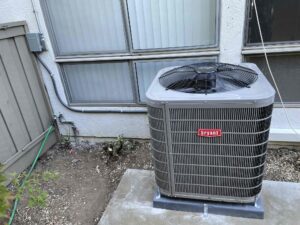
Why Winter Is a Smart Time To Install a New AC Unit
There are several benefits of installing AC in the off-season. Winter is considered the “off-season” for most AC installation companies, which makes it a smart time to invest in an upgrade. Demand for new air conditioning units is typically lower in the winter, resulting in lower prices as well. HVAC technicians have a much less hectic schedule in the winter, so there’s also a lot more flexibility when it comes to scheduling your professional AC installation.
Off-Season Discounts and Manufacturer Rebates
When it comes to getting various discounts and manufacturer rebates, there are many off-season HVAC deals to be found. The deepest discounts for winter AC installation savings are available from November through January, because demand is at its lowest during this time.
You may also benefit from lower labor costs and more flexible scheduling. HVAC contractors are typically less busy, which means you might get new air conditioner cost savings on the upfront cost associated with a new AC installation. Many major AC manufacturers offer additional price discounts and rebates in late winter to clear out older inventory and make room for new inventory.
Along with these savings, you could be eligible for the federal Energy Efficient Home Credit. This credit offers up to $3,200 annually for specific home comfort equipment, including up to $600 for qualifying central air conditioners and up to $2,000 for qualifying heat pumps. Several local incentives are available from the state of California and from certain utility companies, helping you maximize your savings even more.
How a New AC Unit Improves Summer Comfort and Efficiency
As you prepare your home for summer, a new AC unit makes this season much more enjoyable. Here’s how getting a new AC unit improves summer comfort and efficiency:
- More consistent cooling: A new AC unit distributes cold air more consistently throughout your home to help maintain a uniform temperature and eliminate hot spots.
- Better air quality: Modern air conditioners include advanced filtration that removes airborne pollutants and allergens, improving the indoor air quality in your home.
- Lower energy bills: Since newer AC units consume less energy than older models, they provide significant energy savings to reduce your energy bills.
- System improvements: Upgraded features, such as smart thermostat integration and quieter operation, make new AC units easier and more convenient to use.
- Higher SEER ratings: New AC unit models have much higher Seasonal Energy Efficiency Ratio (SEER) ratings, which means they’re much more energy efficient than their predecessors.
The Hidden Costs of Waiting Until Summer To Replace Your AC
Choosing HVAC installation in colder months may seem counterintuitive, but there are several hidden costs associated with waiting until summer to replace your AC. While a new AC has better energy efficiency regardless of when it’s installed, choosing to replace it in the summer costs more because demand during this time of year is much higher, resulting in higher prices for the unit and the installation. Buyers typically pay a premium for new AC units during peak season.
Knowing exactly when to replace your AC unit may seem tricky. However, if you have an older system or your current system is constantly breaking down, replacing it early is the best way to enjoy a cool, comfortable home when summer arrives. You’ll also pay more for emergency repairs during the peak season, so it makes sense to upgrade your AC early to prepare for the summer heat.
Benefits of Professional AC Installation in Colder Months
Why install a new AC before summer? There are several benefits to scheduling professional AC installation during the colder months.
More Convenience
Scheduling a new AC unit installation in the winter gives you access to better appointment availability that works for your busy lifestyle. You’ll also enjoy peace of mind knowing that your home is fully prepared for the hot summer months with a new AC unit that offers improved efficiency and performance.
Cost Savings
In most cases, AC manufacturers lower prices during the winter months, making the upfront cost more affordable. Labor costs may be lower in the winter due to reduced demand for air conditioners. You’ll also be eligible for various incentives like tax credits and rebates to help you save even more money.
Optimal Performance
Regardless of the time of year, installing a new energy-efficient air conditioner provides you with benefits like minimal maintenance and optimal performance. Higher SEER ratings, quiet operation, smart thermostat integration, and improved indoor air quality mean you’ll enjoy a reliable air conditioner that keeps your home cool during the peak summer heat.
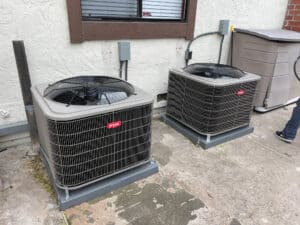
Pairing AC Installation With Other Winter HVAC Services
You can also pair your AC installation with other winter HVAC services, such as a furnace inspection and tune-up. If your furnace is aging and needs to be replaced, winter is an ideal time to upgrade to a new heat pump that provides both energy-efficient heating and cooling in one unit.
You’ll also get more streamlined service and better scheduling to get your heating and cooling needs met in one visit. Addressing your heating needs in the winter is the best way to ensure your system is clean and properly tuned to meet the demands of cold temperatures. Installing a new AC unit at the same time provides the same benefits for hot summer temperatures.
Schedule Your Winter AC Installation With TRIO Heating, Air, & Plumbing
The experts at TRIO Heating, Air, & Plumbing are available for your winter AC installation in the Greater San Francisco Bay area. Choosing to install a new air conditioner in the winter offers a range of benefits, including improved energy efficiency and financial savings. Contact us today to schedule your AC installation or another HVAC service with our company.
What Is Air Scrubbing and How It Improves Indoor Air Quality
What is Air Scrubbing? Understanding the Benefits for Indoor Air Quality
Air scrubber for HVAC systems is a device that’ll improve your indoor air quality (IAQ). It’s an advanced filtration system that minimizes contaminants in your air when the HVAC fan is turned on.
If you’re wondering how air scrubbers work or how to get one installed, call TRIO Heating, Air, and Plumbing today. Our HVAC technicians are based out of San Jose, CA, and we serve Menlo Park, Pacifica, Santa Clara, Sunnyvale, Palo Alto, and other surrounding communities. If you’re in the Greater San Francisco Bay Area and want better indoor air quality, contact our team today to learn your options or to schedule a consultation.

What Is Air Scrubbing?
Depending on where you live in Santa Clara County, the outside air quality may be quite poor, with heavy pollution and high ozone, especially when California wildfires run rampant in the area. Installing HVAC air purification in your home helps immensely with the indoor air quality, because your indoor air gets pulled through your regular air filters, then hits additional technologies to kill bacteria, neutralize pollutants, and further remove smoke and debris from the air.
Air scrubbing is another term for whole-house air purification. You can have this type of advanced air filtration system installed inside your ducts to “clean” the air using state-of-the-art technology to destroy pollutants and remove even the tiniest pollutants, odors, dust, and allergens.
How Do Air Scrubbers Work with HVAC Systems?
Air scrubbing goes beyond your average air filtration system, using light waves and ionizing processes to neutralize contaminants and remove them permanently from your indoor air. They work by:
- Step 1: Drawing air into the air scrubber unit, which is usually installed inside your air ducts.
- Step 2: Pulling air through a HEPA filter, and possibly a second carbon filter to remove larger particles like hair, pet dander, dust, and even odors.
- Step 3: Air passes through a UV light that produces molecules that neutralize viruses, bacteria, and harmful contaminants. These molecules travel through your home, cleaning the air and surfaces.
- Step 4: An ionizer electrically charges ions in the air that make debris attract to surfaces, pulling them out of the air.
This multi-stage process makes your indoor air clean, safe, and healthy to breathe.
Common Indoor Air Quality Issues Air Scrubbers Can Solve
Here are some of the most common IAQ issues air scrubbers solve:
- Allergens and asthma triggers: Dust, pollen, pet dander, and other allergy triggers are pulled from the air, helping to reduce symptoms like itchy eyes, congestion, and a runny nose.
- Mold spores: Local humidity is high, so the more mold spores caught and neutralized by your air scrubber, the lower the chances of mold growth and illness due to exposure.
- Volatile organic compounds (VOCs): VOCs are harmful chemicals released when paint, furniture, and cleaning supplies off-gas, releasing them into the air. Scrubbers capture and remove these harmful chemicals, so you don’t inhale them.
- Smoke and bad smells: Odors like tobacco smoke and cooking smells are neutralized by air scrubbing technology, keeping your home smelling fresh and clean, even if you burn dinner.
- Bacteria and pathogens: Air scrubbers stop bacteria, viruses, and other microorganisms from circulating through your home, keeping you and your family healthier.
Air Scrubber vs. Air Purifier: What’s the Difference?
You may be wondering whether an air scrubber is the same thing as an air purifier. While they have similar jobs, comparing an air scrubber vs. an air purifier is like comparing a vacuum with a broom. They both clean the floor, but one removes debris much more effectively. An air scrubber is the advanced version of a purifier.
- Air purification systems often use high-efficiency particulate air filters, or HEPA filters, to remove dust, pollen, mold, bacteria, and many other airborne particles.
- Air scrubbers, on the other hand, incorporate UV lights and ionizers, along with filtration to remove even more pollutants from the air, including gases, smells, and bacteria.
TRIO offers many indoor air quality solutions. Schedule an in-home consultation today to find out which option is best for you.
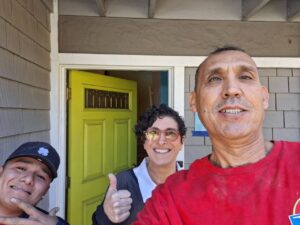
Benefits of Air Scrubbers for Your Home and Health
Health Benefits
When you reduce airborne contaminants in your home, you minimize allergens, volatile chemicals, and other particles. Pollutants and pathogens are broken down at the molecular level to enhance your indoor air quality. This is especially helpful to infants, the elderly, and anybody with allergies, asthma, or respiratory disorders.
Improved HVAC Performance
As long as you continue to schedule regular HVAC maintenance and keep air filters clean, air scrubbers will reduce the strain on your heating and cooling system by reducing the pollutants that can accumulate inside the system and on the coils. This will improve its performance and reduce your energy use.
Potential Rebates
California offers many rebates and tax incentives to homeowners looking to improve their home’s efficiency. You can check the state Climate Action site for HVAC upgrade incentive opportunities, and look up whether your home qualifies for additional rebates when upgrading to an energy-efficient HVAC.
Why Professional Air Scrubber Installation Matters
Air scrubber installation should only be done by a qualified, professional HVAC technician. Otherwise, it could be ineffective, or worse, a safety hazard. At TRIO, we have all the tools, experience, and training required to put your new air scrubber in safely.
When choosing an air scrubber, it’s important to consider factors like:
- The local air quality, including the amount of pollution in and around your home.
- Each system’s manufacturer’s warranty.
- Your home’s layout and ductwork setup.
- Your household’s health, and whether you have specific concerns to address.
Our contractors will correctly position and mount the air scrubber, attach it firmly within your ductwork, and test everything to ensure proper operation. Then they’ll install the filters and give one final thorough evaluation before leaving.
To learn more about putting an air scrubber in, you can count on our team to give you all the info you need after a consultation. We’ll go over costs, timelines, and answer all your questions so you get the right air purification system for your needs.
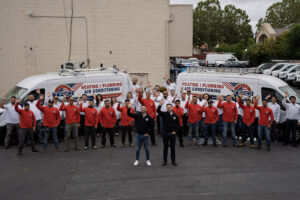
Schedule Air Scrubber Services with TRIO Heating & Air
At TRIO Heating and Air, we always use high-quality products and take the necessary time and care required to do the job right the first time. If you’re looking for a reliable HVAC company to install your air scrubber, contact us at (415) 306-8727 or send us an email through our online form, and our local indoor air quality experts will set your consultation appointment as quickly as possible.
